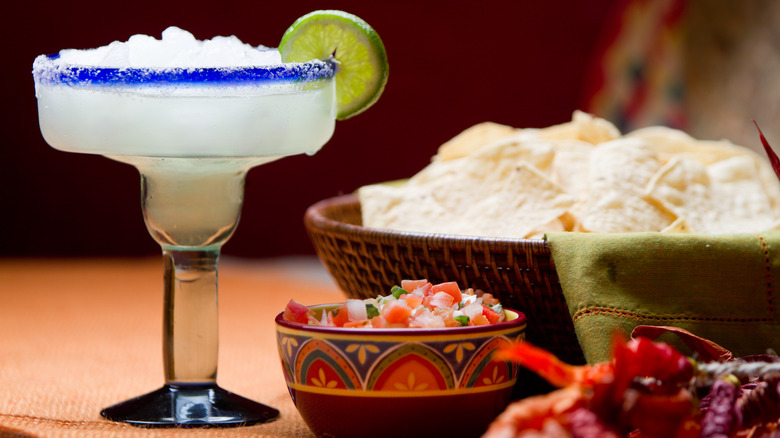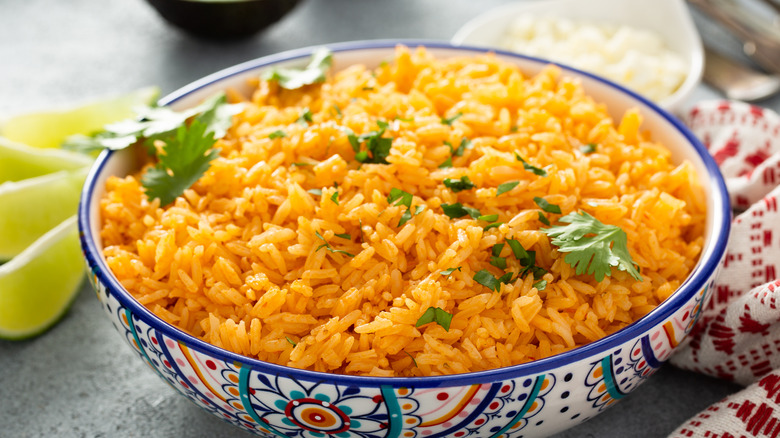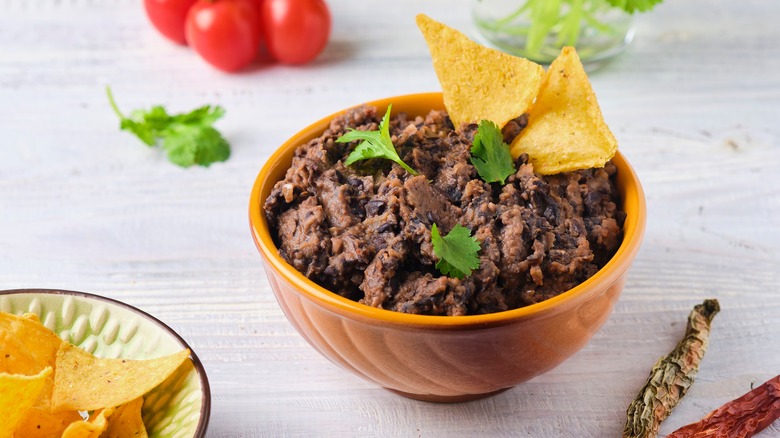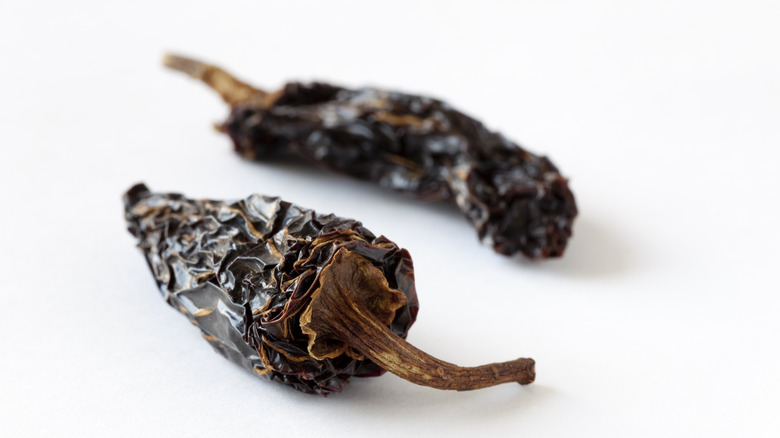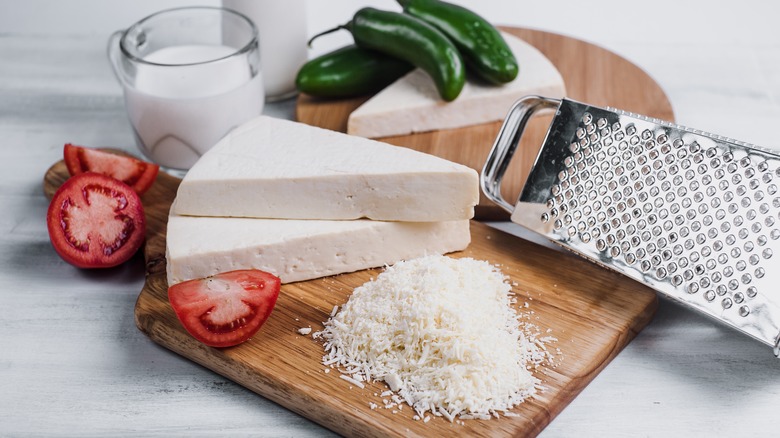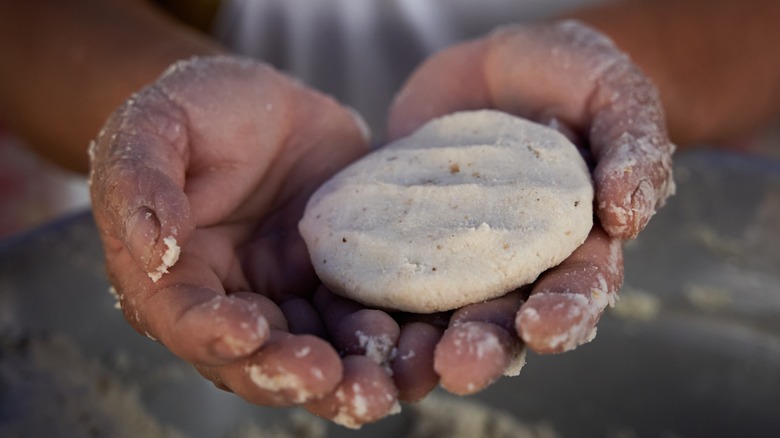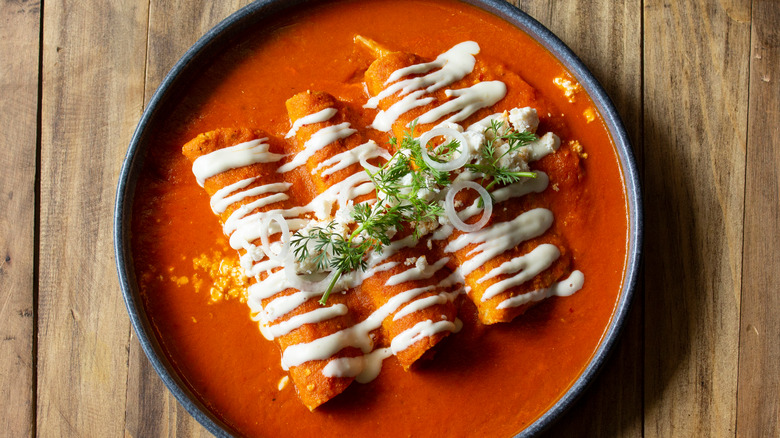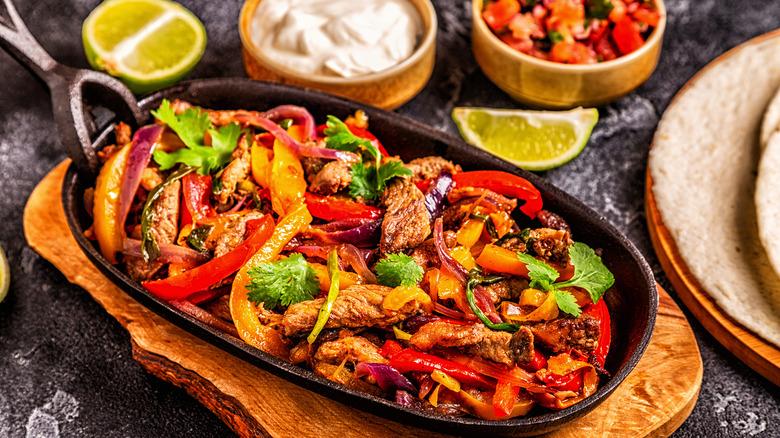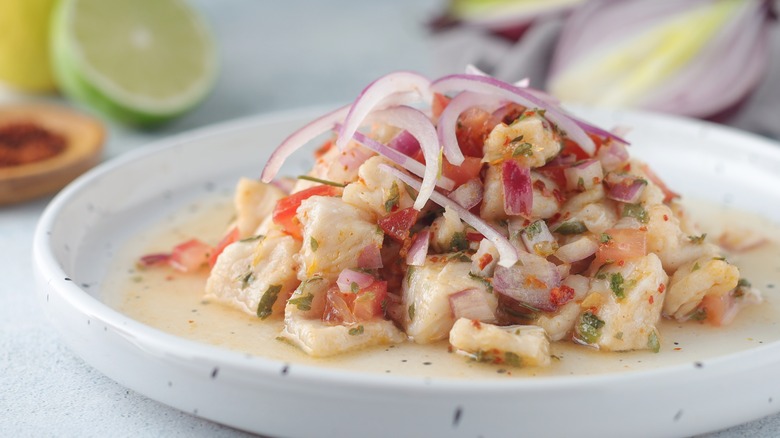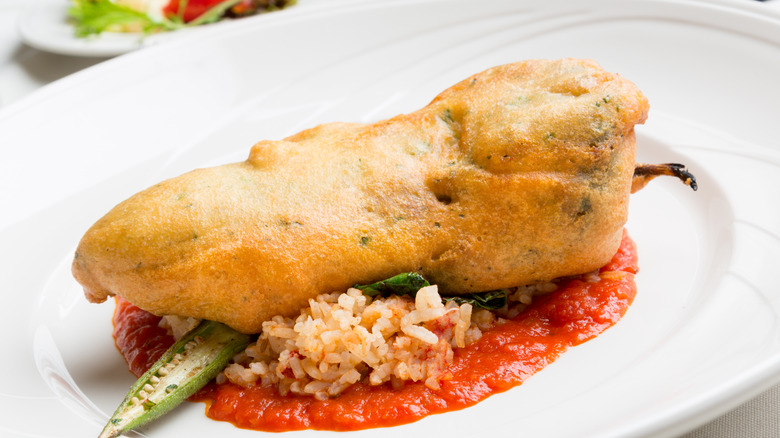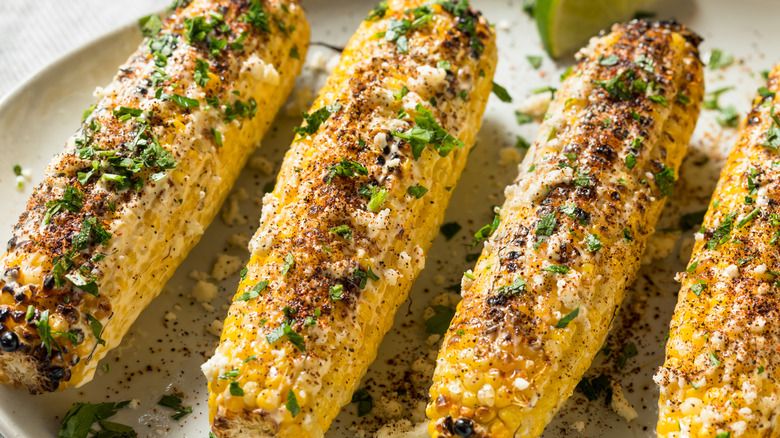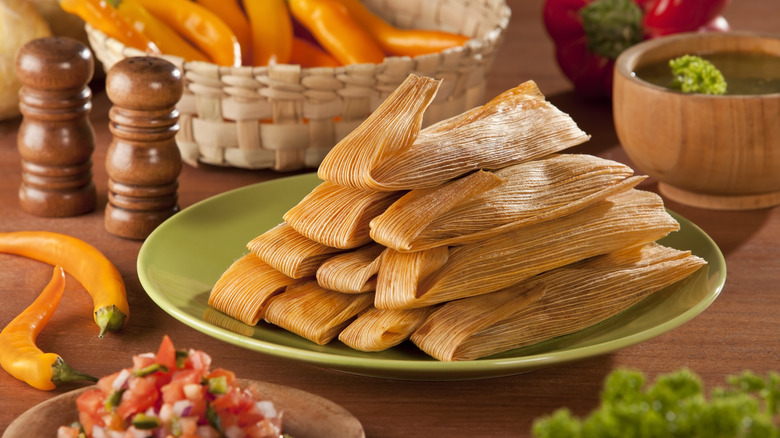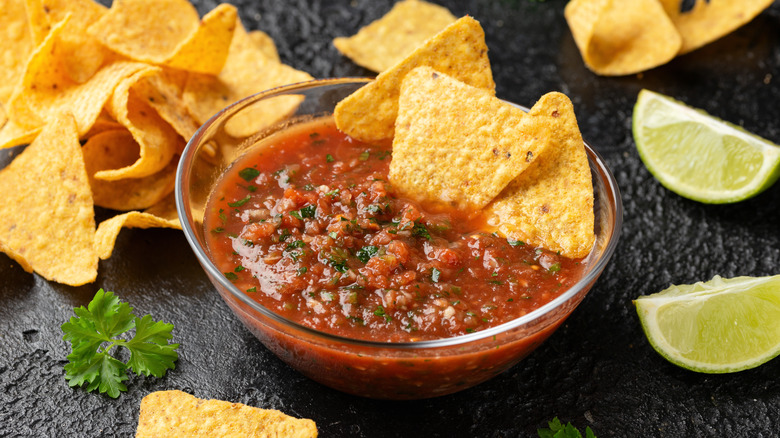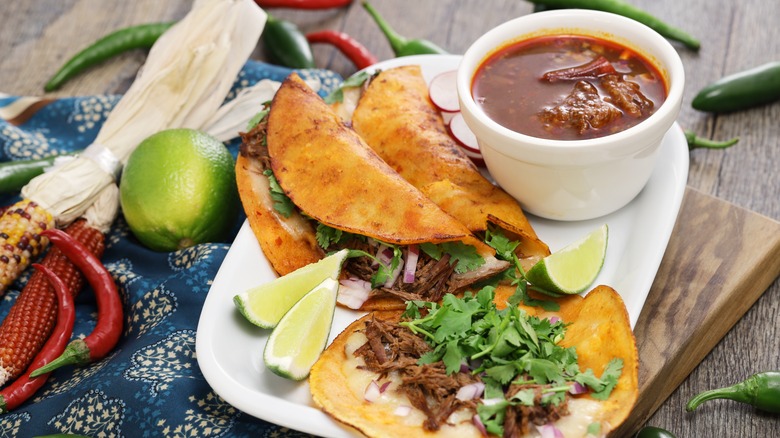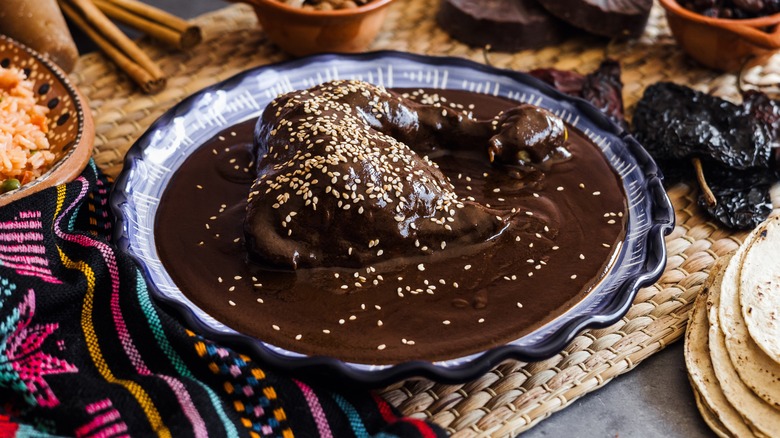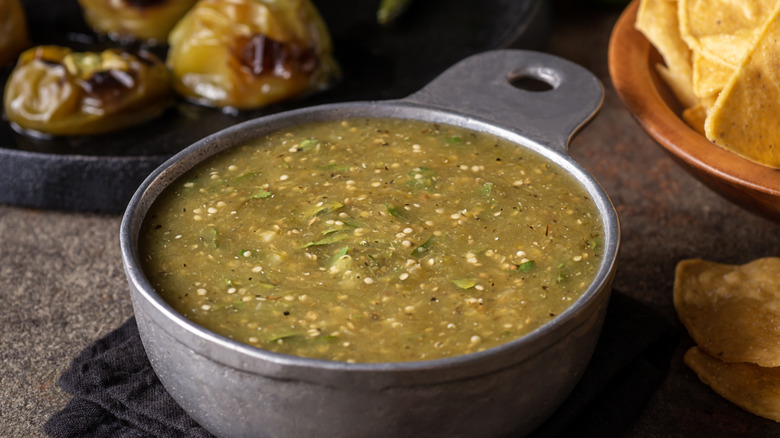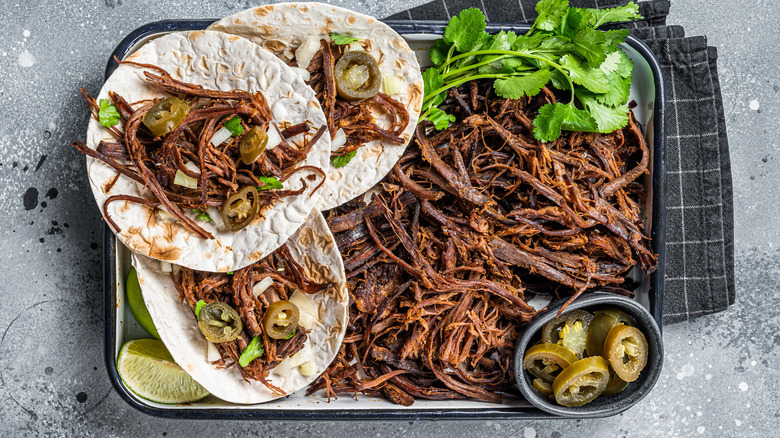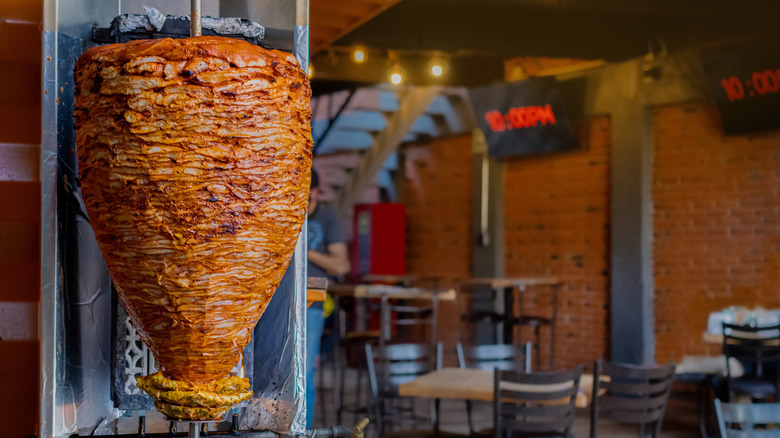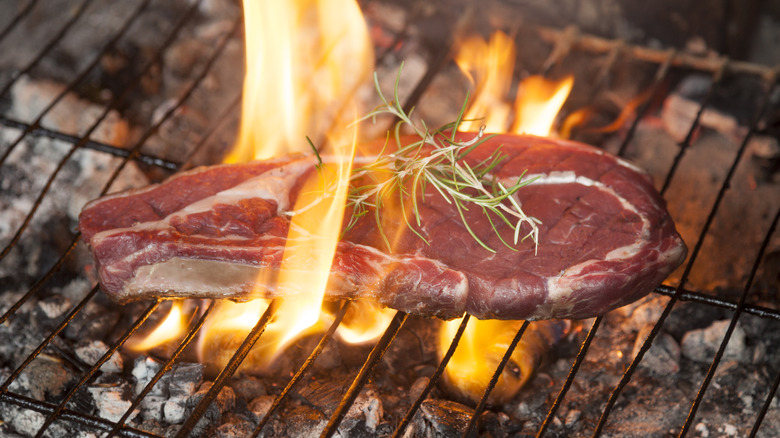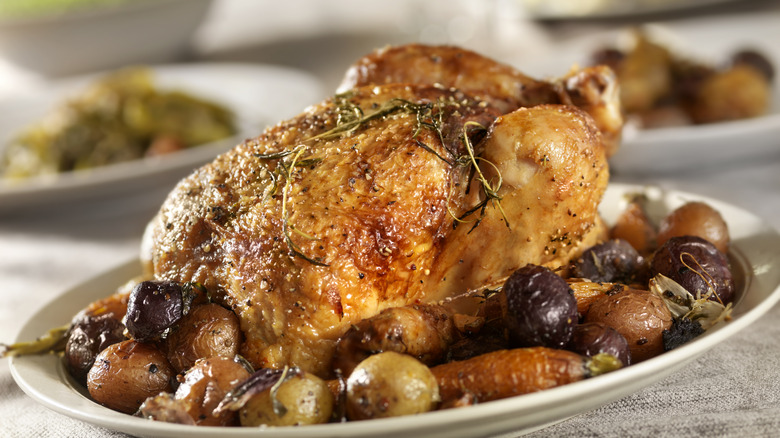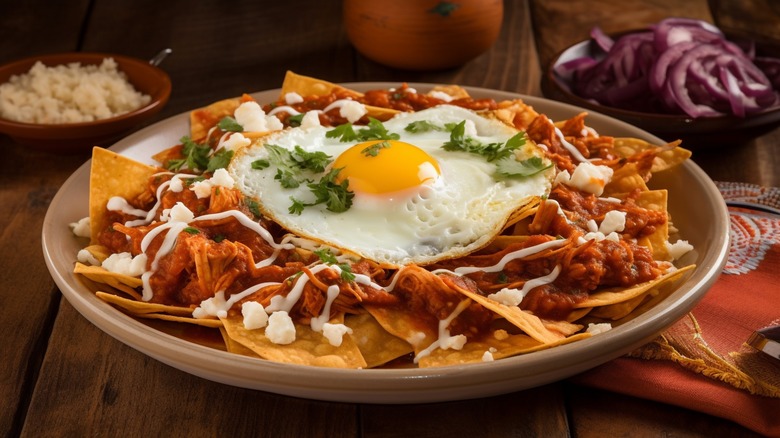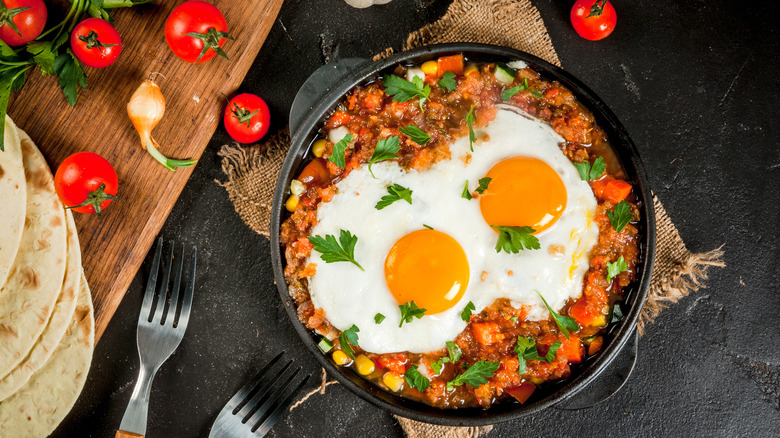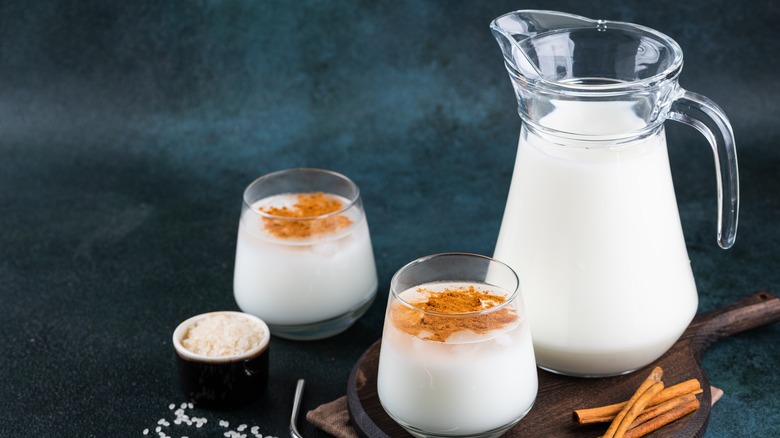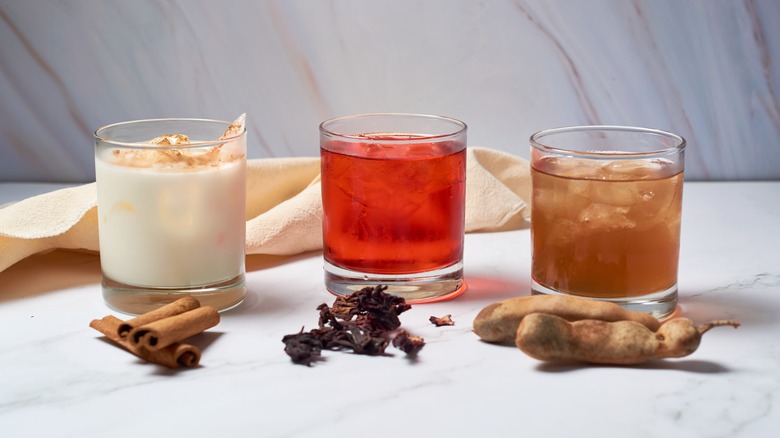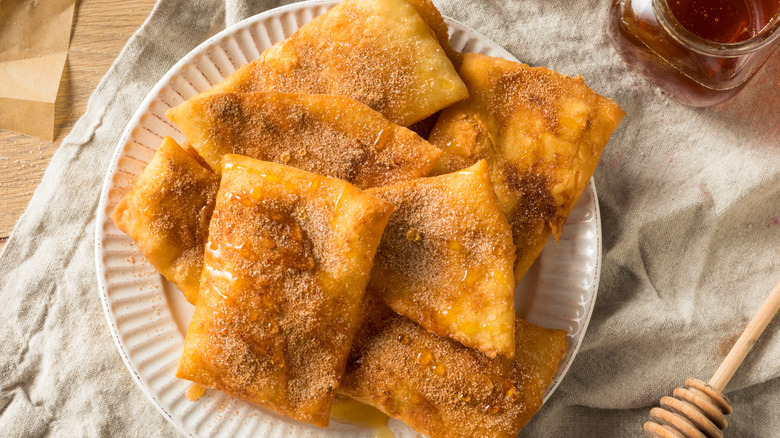27 Essential Words And Phrases To Know At A Mexican Restaurant
Mexican food is one of the most interesting, flavorful, and not to mention popular cuisines in America today (Americans spent more than $66 billion at Mexican restaurants in 2021, per Statista). In fact, Mexican cuisine is now ranked as the third most popular in the world. Mexican cuisine boasts a rich tapestry of flavors and ingredients, with centuries of tradition dating back to Mayan and Aztec times. At the same time, Mexican cuisine is evolving quickly in a contemporary setting, with Southwestern food, which has roots in Mexican and Texan ranching culture, emerging as a popular cuisine in the last several decades.
That said, navigating a menu filled with unfamiliar terms can be daunting. Whether you don't understand what you're ordering, or you simply feel afraid to pronounce the words wrong, ordering traditional Mexican fare may seem impossible. Fear not! This guide will equip you with the essential knowledge to confidently order at any Mexican restaurant. From traditional dishes like enchiladas and tamales to staples like arroz and frijoles, each term offers a glimpse into the vibrant culinary heritage of Mexico. After this crash course, you will feel confident ordering anything off the menu in any Mexican restaurant.
1. Arroz
First, let's cover the basics. Arroz, pronounced ah-roz, simply means rice. This ingredient, a staple of Mexican cooking, is one of the most important ingredients in the cuisine. It provides the basis for most basic Mexican meals, often accompanying main courses or serving as the star ingredient.
Whether served as white rice or zhuzhed up with spices and other ingredients, arroz is pretty much guaranteed to crop up on the menu of any Mexican restaurant. From arroz a la tumboda, a flavorful seafood rice, to arroz amarillo, vibrant yellow rice, there's a variety of ways to enjoy this staple.
2. Frijoles
Frijoles (free-hole-es), Spanish for beans, is another cornerstone of Mexican cuisine, featuring prominently in a variety of dishes. While frijoles could refer to any type of bean, it will usually mean black beans (frijoles negros), pinto beans (frijoles pintos), or kidney beans.
Frijoles refritos, or refried beans, are a popular side dish made from stewed pinto beans which are then mashed, then fried with onion, garlic, fat (traditionally lard), and seasoning. Frijoles, steeped in tradition, are the flavorful workhorse of Mexican cooking.
3. Chipotle
Chipotle (chi-POHT-lay) peppers, which are a staple seasoning in Mexican cuisine, are smoked and dried jalapeños. While the word "chipotle" has become popularized by the eponymous fast-casual restaurant, the ingredient has a long and interesting history; the name "chipotle" originates from the Aztec words "chili" (hot pepper) and "poctli" (smoke), reflecting their smoky flavor.
Chipotles are left to ripen on the vine until red, then smoked to preserve them. These peppers provide a rich, smoky, and spicy flavoring to meats, beans, and other elements of Mexican cooking.
4. Cotija
Cotija (ko-tee-ha) cheese (queso cotija), originating from Cotija de la Paz in Mexico, is a salty, cow's milk cheese used as a seasoning similar to how Italian cuisine uses parmesan. Aged for at least a year, it boasts a crumbly texture similar to feta but with a unique flavor profile. In fact, many European restaurants use feta as a substitute, despite the difference in flavor.
Cotija is often used as a topping for tacos and enchiladas. A sign of authentic Mexican cuisine on any menu, the word "cotija" is a valuable one to know for the educated restaurant-goer.
5. Huevos
Pronounced "way-vos," huevos are one of the simplest ingredients on this list. There is nothing special about them; they are just good old-fashioned eggs.
Eggs will crop up frequently on Mexican breakfast menus in various forms. Whether fried, poached, or scrambled, eggs play a prominent role in many traditional Mexican recipes, adding richness and flavor to a wide array of dishes. Further down on this list, some of the most popular Mexican breakfast dishes are discussed.
6. Masa
Masa (mah-sah) is perhaps even a more important component of Mexican cuisine than arroz and frijoles. The term refers to a dough crafted from hominy (corn), water, and a pinch of salt. This versatile ingredient serves as the foundation for various traditional Mexican dishes, notably corn tortillas.
Since food wrapped or cooked into masa is portable, these dishes are extremely common in traditional Mexican cuisine, because laborers, soldiers, or travelers could carry their lunches with them. This is why dishes like tacos, gorditas, and tamales are so widespread.
7. Enchiladas
Enchiladas (en-chill-AH-das), a popular dish in Mexican cuisine, boast a history dating back to the Mayans. Even El Cocinero Mexicano, the first documented Mexican cookbook, contains a version of this dish. Enchiladas consist of corn tortillas stuffed with filling (usually meat or vegetables with cheese) and then slathered in sauce. Usually, this is a tomato-based chili sauce, but tomatillo sauce is also used.
While enchiladas may sound similar to burritos, there are several key differences; burritos are made with flour tortillas instead of corn, and they are almost never covered with sauce.
8. Fajitas
Fajitas (fah-hee-tas), a Tex-Mex favorite, is a dish that, while popular in Mexican restaurants, actually originated in the American Southwest. Fajitas consist of grilled beef or chicken served sizzling on a skillet with onions and peppers. Accompanied by tortillas, guacamole, sour cream, and salsa, they offer a DIY approach to Southwestern food.
Emerging from the cattle ranches of West Texas and Northern Mexico, fajitas evolved from the practice of grilling meat over open flames. The term "fajita" derives from the Spanish word "faja," meaning "belt" or "sash," referencing the long, thin cut of skirt steak traditionally used.
9. Ceviche
Ceviche, originating from Peru, is a zesty seafood delicacy cherished across Latin America including in many Mexican restaurants. Restaurant-goers who are in the mood for a light, refreshing dish may want to opt for this dish, which consists of raw fish marinated in citrus juices, typically lime or bitter orange. Mixed with onions, chili peppers, and salt, it offers a vibrant culinary experience.
Whether enjoyed on a sunny beach or in a bustling city, ceviche epitomizes the essence of Latin American cuisine with its bold flavors and cultural significance.
10. Empanadas
Empanadas are pastries with a rich history and global appeal. Originating from Spain, these crescent-shaped delights are made from flour or masa and filled with a variety of ingredients. Common fillings include either chicken or vegetables like bell peppers and onions — though the options are infinite, especially in contemporary Mexican kitchens.
Empanadas can be fried or baked until golden brown, creating a crispy exterior that encases a flavorful interior. This dish, which is so popular that cuisines all over the world have adopted their own version, is definitely a must-try.
11. Chile relleno
Chile relleno (reh-yeh-noh), a staple of Mexican cuisine, translates to "stuffed chile" in English. This iconic dish typically features roasted poblano peppers filled with cheese, coated in egg batter, and fried. The spicy, peppery flavor of the poblano is counteracted beautifully by the cheese and golden-grown batter, making for a well-balanced and tasty treat.
While its exact origins are debated, one popular legend credits nuns in Puebla, Mexico, with inventing the dish in 1821 to celebrate Mexican independence. However, historians suggest earlier versions existed. Despite its murky history, chile relleno remains a beloved culinary tradition enjoyed worldwide.
12. Elotes
Elotes (eh-LOH-tes), deriving from the Spanish word for corn, is a quintessential Mexican street food. Typically enjoyed during summertime, elotes are synonymous with street carts and vibrant flavors. The dish features fresh corn on the cob slathered with mayonnaise or butter, sprinkled with chili powder, coated in cotija cheese, drizzled with lime juice, and garnished with cilantro.
With their humble origins as street fare, elotes are proof that any dish can be rebranded, as the snack is now a popular appetizer in many upscale Mexican eateries.
13. Tamales
Speaking of quintessentially Mexican foods, tamales (tah-mah-lehs) are another dish that is deeply ingrained in Mexican food culture. They are used in celebratory meals on occasions such as Christmas, Easter, the Day of the Dead, and more.
Tamales consist of masa enveloping an array of fillings like cheese, meats, and spices. The mixture is then wrapped in corn husks and steamed, yielding a soft, delicate corn flavor contrasted by boldly spiced fillings. The history of tamales is murky, coming either from Aztec or Maya tradition. Either way, tamales have been a staple Latin American dish for a long time.
14. Salsa
Sauces are one of the most important aspects of Mexican cuisine. Salsa, which is simply the Spanish word for "sauce," has taken on a more specific meaning in the realm of Mexican cuisine. It typically refers to a savory blend of diced fresh tomatoes, onions, and chili peppers, often served as a dip or condiment. This vibrant mixture adds a burst of flavor to various dishes, from tacos to tortilla chips.
While salsa can vary in spiciness and ingredients, its essence lies in its ability to complement and enhance the flavors of Mexican cuisine.
15. Birria
Birria is a flavorful beef stew renowned for its tender meat cooked in a rich broth called "consomé." Often enjoyed as a comforting meal, birria is cherished for its depth of flavor and versatility. In a contemporary setting, birria has become more frequently associated with tacos.
Birria tacos are filled with the meat from the birria consomé, as well as cheese and any other condiments, then dipped into the consomé before being cooked, either on the grill top or stovetop. The result is a mouthwatering fusion of flavors.
16. Mole
Mole (MOH-lay) derives from the Aztec word molli, meaning "sauce." It's a complex Mexican sauce made with chilis, fruits, nuts, and spices like cumin and cinnamon. Despite its association with chocolate, not all mole variations include it.
Crafting mole is an intricate process, often taking hours or even days; the result is a symphony of flavors, where chocolate (sometimes), chilis, garlic, and cinnamon come together to create a unique taste profile. Mole sauce is often cooked with chicken (chicken mole), enchiladas, or even tacos.
17. Salsa verde
Salsa verde (ver-day), literally translating to "green sauce," is a vibrant, tangy condiment distinguished by its verdant hue. Unlike red salsa, it features tomatillos as its primary ingredient, imparting a unique tartness. Complemented by cilantro, onions, and chilies, its flavor profile is fresh and zesty.
With its versatile and refreshing taste, this salsa has become a beloved accompaniment to many Mexican meals, adding a burst of flavor and a touch of brightness to each bite.
18. Barbacoa
Barbacoa (bar-bah-ko-ah), originating from the Taíno language, is the ancestor of the word "barbecue." It originally referred to a wood-burning pit used for cooking meats. In Mexico, barbacoa evolved into a tradition involving slow-cooking meat in a pit lined with heated rocks and agave or maguey leaves. This method produces tender shredded meat, often beef, lamb, goat, or mutton.
While barbacoa is frequently seen at restaurants, the dish is not frequently made at home, simply because of the labor that goes into cooking it.
19. Al pastor
Al pastor, translating to "shepherd style," (pastor and pasture share a common root) is a Mexican meat preparation method typically involving pork. The meat is typically marinated in acid, heat, and salt, with ingredients such as pineapple, chili, and cilantro.
What distinguishes al pastor is its cooking technique on a vertical spit called a trompo. Pork shoulder is stacked on the trompo and slow-cooked for hours until tender, and then thinly sliced. The thinly sliced pork can then be used in a variety of dishes, such as tacos or burritos.
20. Carne asada
Carne (car-nay) asada, translating to "grilled meat," is a beloved staple of Mexican cuisine. This dish typically features marinated beef, commonly skirt or flank steak, grilled over an open mesquite fire. The marinade often includes garlic, jalapeños, and citrus juices like lime and orange, which tenderize the meat and infuse it with tangy flavor. Simple seasonings like salt, pepper, and cilantro complement the marinade.
Carne Asada's versatility allows it to serve as a base for various dishes, accommodating a range of toppings and preparations. Loved for its juicy, flavorful taste, carne asada embodies the rich tradition of Mexican grilling.
21. Pollo
Pollo (poh-yo) translates in English simply as "chicken." Unlike the previous meat discussed, pollo refers to the meat itself instead of the method of cooking. Introduced during Spanish colonization, chicken has since become a staple protein source in Mexican cooking.
Both breast and thigh meat are utilized, with breast meat commonly shredded for dishes like tacos and enchiladas. The tender, flavorful dark meat is favored for searing and stewing, thanks to its higher fat content. From comforting stews to zesty tacos, pollo plays a central role in the vibrant flavors of Mexican cuisine.
22. Chilaquiles
Chilaquiles (chee-lah-key-les), a beloved Mexican breakfast staple, consist of fried tortilla pieces smothered in salsa verde or red sauce. This flavorful dish is a perfect solution for using up leftover tortillas, as they are fried until crispy and then topped with zesty salsa.
Chilaquiles can be customized to suit individual preferences, with additional toppings like shredded chicken, eggs, cheese, avocado, and crema. Despite their simplicity, chilaquiles pack a punch of flavor, combining the crunchiness of tortillas with the boldness of salsa.
23. Huevos rancheros
Diligent readers will remember that "huevos" means "eggs" in English, and may guess that "rancheros" may have something to do with Southwestern ranching. Huevos rancheros, a classic Mexican breakfast dish, translates to "rancher's eggs." It features fried eggs served on a base of tortillas, often accompanied by savory toppings like homemade salsa, fried potatoes, avocado slices, and frijoles refritos.
This hearty breakfast food is an excellent choice for a solid morning meal that embraces Mexican tradition.
24. Horchata
Horchata (or-CHAHT-ah), a beloved beverage in Mexico, is a refreshing concoction made from rice water infused with cinnamon and vanilla. This creamy, sweet drink is a staple on Mexican menus, offering a delightful combination of comfort and freshness. The drink is made by soaking raw rice and cinnamon in water and then blending with milk, vanilla, and sweetened condensed milk.
Perfect for sipping on a hot day as a treat or as an accompaniment to a spicy meal, horchata is cherished for its delicious, sweet taste and cooling properties.
25. Agua fresca
Aguas frescas, meaning "fresh waters" in Spanish, are refreshing beverages made from fresh fruit juice, water, and occasionally a touch of cane sugar. Popular in Mexican cuisine, these drinks offer a delightful way to cool down, particularly on hot days. With a flavor profile similar to fruit juice but lighter, these drinks are often made with melon, pineapple, hibiscus, or any number of herbs.
Whether enjoyed as a standalone refreshment or paired with a meal, an agua fresca provides a burst of fruity flavor and hydration.
26. Sopapilla
The sopapilla (so-pay-pee-yah) originated in New Mexico over 200 years ago, when the region was still a part of Mexico. The dish consists of a crispy fried pastry traditionally topped with sugar or honey and spices like cinnamon and served as a dessert. However, sopapillas can also be enjoyed as an entree when stuffed with savory fillings like meat, cheese, and peppers.
Regardless, these delightful pastries remain a cherished part of Hispanic culinary traditions, offering both sweet and savory indulgence.
27. Tres leches cake
Tres leches cake, originating from Mexico, is a delectable dessert soaked in three types of milk: evaporated milk, condensed milk, and cream. Its roots trace back to the 19th century when a similar concept existed using wine-soaked bread. However, it was popularized in the 1930s when Nestle printed a recipe on their cans of evaporated milk, condensed milk, and cream, bringing it into the mainstream.
Today, tres leches cake remains a beloved treat in Mexican cuisine, cherished for its moist texture and sweet flavor.
